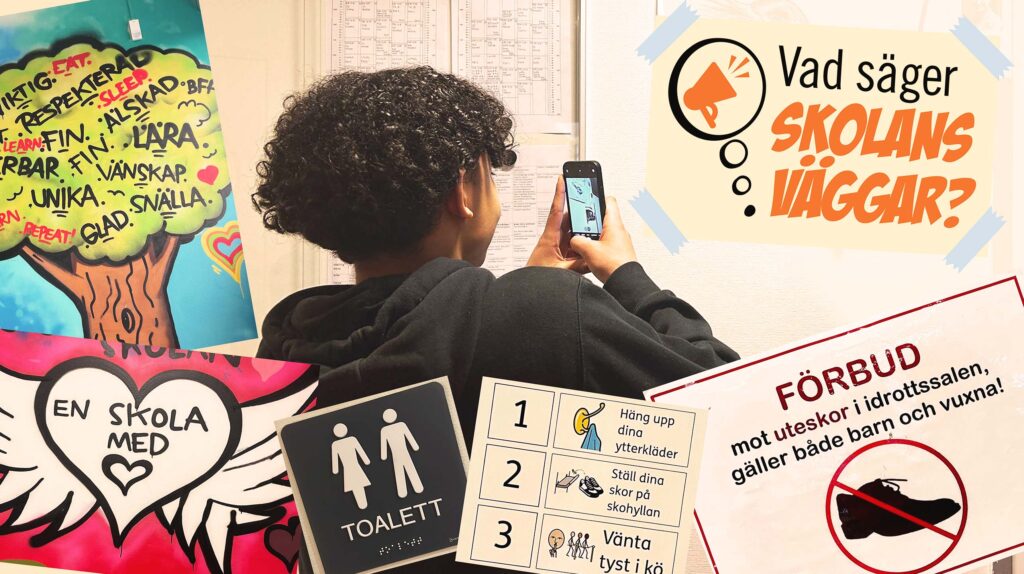School walls are covered with signs, posters, and artwork, but who are these messages aimed at, who created them, and how do they reflect school democratic values? These were the questions explored by pupils and researchers in the Swedish project Voices of the Walls. The result: a greater sense of involvement among pupils and a call for more art on school walls.

One of the school’s core responsibilities is to give pupils a voice in their education and to strengthen their understanding of values, norms and rights. In the citizen science project Voices of the Walls, pupils across Sweden helped researchers investigate how this mission is reflected in the messages displayed in their schools.
During autumn 2024, primary and secondary school classes photographed and analysed signs, posters, drawings, graffiti and other messages found on their school walls. Participating schools spanned the whole of Sweden, from north to south and east to west, covering both urban and rural areas.
Nearly 500 photographs, one per participant, were submitted to Mona Blåsjö, Professor of Swedish at Stockholm University and Charlotte Engblom, a lecturer in didactics at Uppsala University, who carried out further analysis. The final report has now been published, and the researchers believe that both pupils and teachers gained new insights into their school environment through the project.
“In academic terms, you could say they became more semiotically aware – in other words, they started reflecting on what was and wasn’t present on the walls, and what they thought about it. Some commented, for example, on the lack of art, and wondered why pupils write graffiti on the walls. Others asked for more uplifting messages, while others highlighted the importance of safety information,” says Charlotte Engblom.
Greater awareness and a stronger sense of agency
The pupils’ photos also revealed that many school walls display messages about values, and often feature hearts in various forms and materials, but there were also plenty of prohibitions and information notices. Very few of the messages, however, had been created by the pupils themselves. Charlotte Engblom hopes the project helps pupils feel more able to influence their surroundings.
“Taking time to reflect and investigate creates an awareness that can lead to change – change that pupils and teachers want. Because the pupils took the photos themselves, they were the ones in control of what was documented. In this way, they gained agency. And having agency is crucial for those affected by an environment if you want to achieve change.”
David Borgström, Project Manager at the non-profit organisation Public & Science Sweden, who managed the project, agrees:
“There is often talk of declining democratic engagement among young people, but in order for them to believe in democracy, we need to strengthen their sense of belonging and influence in the place where they spend every day: school. That’s exactly what we wanted to do with this project, and it feels like we succeeded.
Voices of the Walls in numbers
- Nearly 500 pupils from 25 classes in 14 schools across Sweden took part in the project.
- The pupils submitted almost 500 photographs of their school walls.
- Around 100 pupils were from primary schools, and 400 from secondary schools.
Key findings
- To inform was the most common function pupils identified in the messages on school walls (about 40%), followed by ”other functions” (13%), ”to prompt action” (12%) and ”to entertain” (9%). The ”other functions” included adverts, greetings (such as “Welcome”) or calls to take pride in something.
- Mostly paper-based – despite increasing digitalisation, around 40% of the messages were made of paper.
- Very little educational content – surprisingly few messages related to education or learning.
- Where is the pupil-produced content? Very few of the messages were created by pupils. Instead, the walls were dominated by professionally produced, printed materials, whether related to education, values or decoration.
- Graffiti – pupils saw various functions in graffiti, such as expressing coolness or simply having something to do when bored.
Further information
Voices of the Walls was a collaboration between language and educational science researchers from Stockholm University and Uppsala University, and the non-profit organisation Public & Science Sweden. The project was part of the annual ForskarFredag science festival, European Researchers’ Night in Sweden, funded by the EU’s Horizon Europe research and innovation programme in the framework of the Marie Sklodowska-Curie actions.
Contact
- David Borgström: [email protected] | +46 (0)70 740 18 56
- Mona Blåsjö: [email protected] | +46 (0)70 816 64 36
- Charlotte Engblom: [email protected] | +46 (0)70 459 13 62
